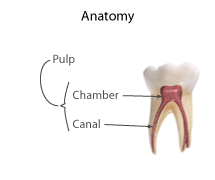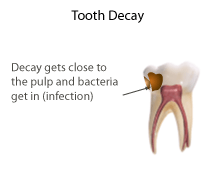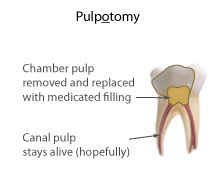Pulpotomy
A pulpotomy is the removal of a portion of the pulp, including the diseased aspect, with the intent of maintaining the vitality of the remaining pulpal tissue by means of a therapeutic dressing.[1] A healthy tooth has a space inside it called the "pulp space" which is filled with soft tissues - nerves, blood vessels, and pink connective tissue. If a tooth gets a large cavity, the bacteria in the decay can damage the pulp, which is often what causes toothache.

Damage to the pulp of permanent teeth usually requires a Root Canal Treatment or Endodontic Therapy. The pulp of primary or deciduous teeth, which only have to survive until an adult teeth come in, and because they have a better blood supply, can sometimes be saved.
Indications
Primary teeth
Primary (Baby) teeth in children have relatively large pulp spaces and a cavity does not have to get very large before it reaches the pulp chamber.

When the soft tissue in the pulp chamber is infected (has bacteria in it) or affected (is inflamed), it can be removed by a dentist under local anaesthetic. If the soft tissue in the canals is still healthy enough, a special medicated filling can be put into the chamber in an attempt to keep the remaining pulp (in the canals) alive. The process of removing the pulp from the chamber is the actual "pulpotomy", though the word is often used for the entire process including placement of the medication.

Afterwards the tooth is restored with a regular filling or a stainless steel crown.
A pulpotomy can be done to both permanent and primary teeth.
Types
Partial Pulpotomy for Carious Exposures
In some cases an adult tooth might have decay down to the pulp but the pulp is still pretty healthy. If the roots haven't finished forming yet, a partial pulpotomy might give it a chance to finish forming.
Partial Pulpotomy for Traumatic Exposures
A partial pulpotomy for traumatic exposures is also called a Cvek Pulpotomy. When a baby tooth or young permanent tooth is traumatised - say, hitting your teeth on the handlebars of a bike - it can be broken in such a way that the pulp is exposed. Again, a partial pulpotomy may help it to finish developing and be saved.
Medicaments
In primary teeth medicaments such as formocresol, Mineral trioxide aggregate, Zinc oxide eugenol and Calcium hydroxide can be used in pulpotomy. Formocresol use has been questioned due to toxicity concerns.[2]
Ferric sulphate, sodium hypochlorite[3][4] or a local anaesthetic solution containing a vasoconstrictor agent can be used to arrest any bleeding from the pulp prior to the placement of medicament.
Alternative pulpotomy techniques
Electro-surgery pulpotomy
Also known as non-chemical devitalization. Its mechanism of action is the cauterization of the pulp tissue. It carburizes heat-denaturated pulp and bacterial contamination.
Laser pulpotomy
This technique overcomes histological effects of electro-surgery. It creates a superficial zone of coagulation or necrosis that remains compatible with the underlying tissue and isolates the pulp from vigorous effects of the sub-base.
Objectives
- Maintenance of radicular portion vitality.
- Post-op clinical and radiographic evaluation should show no complications such as pain, swelling, sinus presence internal resorption or abnormal canal calcification. Additionally, the formation of a radiolucency subjacent to the furcation in primary teeth can indicate failure.
- Neither breakdown of the supporting tissue, nor trauma to succedaneous teeth should be detected.
See also
References
- ↑ http://www.ada.org/glossaryforprofessionals.aspx#p[]
- ↑ Godhi, Brinda; Sood, PB; Sharma, Arun (2011). "Effects of mineral trioxide aggregate and formocresol on vital pulp after pulpotomy of primary molars: An in vivo study". Contemporary Clinical Dentistry. 2 (4): 296–301. doi:10.4103/0976-237X.91792. PMC 3276856
 . PMID 22346156.
. PMID 22346156. - ↑ Shabzendedar, Mahboobeh; Mazhari, Fatemeh; Alami, Maliheh; Talebi, Maryam (2013). "Sodium hypochlorite vs formocresol as pulpotomy medicaments in primary molars: 1-year follow-up". Pediatric Dentistry. 35 (4): 329–32. PMID 23930631.
- ↑ Al-Mutairi, MA; Bawazir, OA (2013). "Sodium hypochlorite versus Formocresol in primary molars pulpotomies: a randomized clinical trial". European Journal of Paediatric Dentistry. 14 (1): 33–6. PMID 23597217.
External links
- American Academy of Pediatric Dentistry website
- Markovic, D; Zivojinovic, V; Vucetic, M (2005). "Evaluation of three pulpotomy medicaments in primary teeth". European Journal of Paediatric Dentistry. 6 (3): 133–8. PMID 16216093.